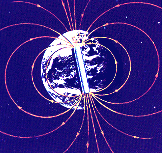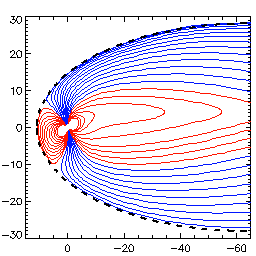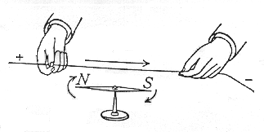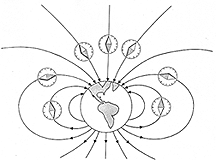|
The ancient Greeks, originally those near the city of Magnesia, and also the early Chinese knew about strange and rare stones
(possibly chunks of iron ore struck by
lightning) with the power to attract iron. A steel needle stroked with such a "lodestone" became "magnetic" as
well, and around 1000 the Chinese found that such a needle, when freely
suspended, pointed north-south. The magnetic compass soon spread to Europe. Columbus used it when he crossed the Atlantic ocean, noting not only that the needle deviated slightly from exact north (as indicated by the stars) but also that the deviation changed during the voyage. Around 1600 William Gilbert, physician to Queen Elizabeth I of England, proposed an explanation: the Earth itself was a giant magnet, with its magnetic poles some distance away from its geographic ones (i.e. near the points defining the axis around which the Earth turns).
The Magnetosphere On Earth one needs a sensitive needle to detect magnetic forces, and out in space they are usually much, much weaker. But beyond the dense atmosphere, such forces have a much bigger role, and a region exists around the Earth where they dominate the environment, a region known as the Earth's magnetosphere. That region contains a mix of electrically charged particles, and electric and magnetic phenomena rather than gravity determine its structure. We call it the Earth's magnetosphere Only a few of the phenomena observed on the ground come from the magnetosphere: fluctuations of the magnetic field known as magnetic storms and substorms, and the polar aurora or "northern lights," appearing in the night skies of places like Alaska and Norway. Satellites in space, however, sense much more: radiation belts, magnetic structures, fast streaming particles and processes which energize them. All these are described in the sections that follow.
But what is magnetism?Until 1821, only one kind of magnetism was known, the one produced by iron magnets. Then a Danish scientist, Hans Christian Oersted, while demonstrating to friends the flow of an electric current in a wire, noticed that the current caused a nearby compass needle to move. The new phenomenon was studied in France by Andre-Marie Ampere, who concluded that the nature of magnetism was quite different from what everyone had believed. It was basically a force between electric currents: two parallel currents in the same direction attract, in oposite directions repel. Iron magnets are a very special case, which Ampere was also able to explain.
In nature, magnetic fields are produced in the rarefied gas of space, in the glowing heat of sunspots and in the molten core of the Earth. Such magnetism must be produced by electric currents, but finding how those currents are produced remains a major challenge.
Magnetic Field LinesMichael Faraday, credited with fundamental discoveries on electricity and magnetism (an electric unit is named "Farad" in his honor), also proposed a widely used method for visualizing magnetic fields. Imagine a compass needle freely suspended in three dimensions, near a magnet or an electrical current. We can trace in space (in our imagination, at least!) the lines one obtains when one "follows the direction of the compass needle." Faraday called them lines of force, but the term field lines is now in common use.
Fi eld lines of a bar magnet are commonly illustrated by iron filings sprinkled on a sheet of paper held over a magnet. Similarly, field lines of the Earth start near the south pole of the Earth, curve around in space and converge again near the north pole. However, in the Earth's magnetosphere, currents also flow through space and modify this pattern: on the side facing the Sun, field lines are compressed earthward, while on the night side they are pulled out into a very long "tail," like that of a comet. Near Earth, however, the lines remain very close to the "dipole pattern" of a bar magnet, so named because of its two poles.
 Magnetic field lines from an idealized model. Magnetic field lines from an idealized model.To Faraday field lines were mainly a method of displaying the structure of the magnetic force. In space research, however, they have a much broader significance, because electrons and ions tend to stay attached to them, like beads on a wire, even becoming trapped when conditions are right. Because of this attachment, they define an "easy direction" in the rarefied gas of space, like the grain in a piece of wood, a direction in which ions and electrons, as well as electric currents (and certain radio-type waves), can easily move; in contrast, motion from one line to another is more difficult. A map of the magnetic field lines of the magnetosphere, like the one displayed above (from a mathematical model of the field), tells at a glance how different regions are linked and many other important properties.
Electromagnetic WavesFaraday not only viewed the space around a magnet as filled with field lines, but also developed an intuitive (and perhaps mystical) notion that such space was itself modified, even if it was a complete vacuum. His younger contemporary, the great Scottish physicist James Clerk Maxwell, placed this notion on a firm mathematical footing, including in it electrical forces as well as magnetic ones. Such a modified space is now known as an electromagnetic field.Today electromagnetic fields (and other types of field as well) are a cornerstone of physics. Their basic equations, derived by Maxwell, suggested that they could undergo wave motion, spreading with the speed of light, and Maxwell correctly guessed that this actually was light and that light was in fact an electromagnetic wave. Heinrich Hertz in Germany, soon afterwards, produced such waves by electrical means, in the first laboratory demonstration of radio waves. Nowadays a wide variety of such waves is known, from radio (very long waves, relatively low frequency) to microwaves, infra-red, visible light, ultra-violet, x-rays and gamma rays (very short waves, extremely high frequency). Radio waves produced in our magnetosphere are often modified by their environment and tell us about the particles trapped there. Other such waves have been detected from the magnetospheres of distant planets, the Sun and the distant universe. X-rays, too, are observed to come from such sources and are the signatures of high-energy electrons there.
|
 More about the magnetosphere
More about the magnetosphere What Oersted saw...
What Oersted saw... More about magnetism
More about magnetism Compass needles outlining field lines
Compass needles outlining field lines More about magnetic field lines
More about magnetic field lines More about electromagnetic waves
More about electromagnetic waves